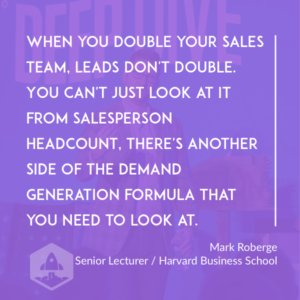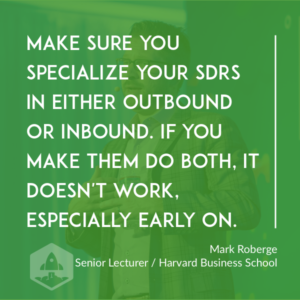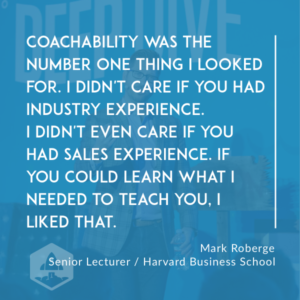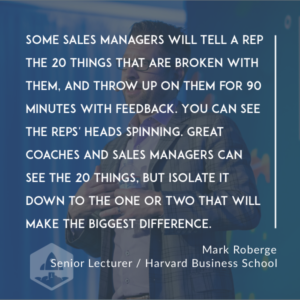Mark Roberge, Senior Lecturer at Harvard Business School and former CRO at Hubspot, takes the Deep Dive Stage to answer burning questions that we all have about sales and running a successful sales organization.
What’s the ideal churn rate for your sales team? How do you deal with the product team blaming the sales team, and vice versa, when you don’t hit your numbers? Why should you consider account-based marketing? What’s the benefit of choosing coachability over experience when hiring salespeople?
Mark answers all these questions and more in this insightful and eye-opening talk.
And if you haven’t heard: SaaStr Annual is only two weeks away, and we’ve made it bigger and better than ever! Join 10,000 fellow founders, investors and execs for 3 days of unparalleled networking and epic learnings from SaaS legends like Jon Miller, David Steinberg, Jennifer Tejada, and Eoghan McCabe. If you don’t have tickets, there’s still time to grab yours today and bring your team from just $999! (Hurry before they’re all gone!) Get tickets here.
TRANSCRIPT
Announcer: Time to answer all of your burning sales questions. Please welcome Senior Lecturer at Harvard Business School and the author of the best selling book, “The Sales Acceleration Formula,” Mark Roberge.
Mark Roberge: Thanks for coming out. I’m glad we’re able to spend a little more time than downstairs in a little more intimate session. It’s all you, Q&A. I think we’ve got 35 minutes to fire away. I think there’s running around, shoot up your hand and we’ll get you a mic. What have you got?
[music]
Male Participant: I am just curious, Mark. What is your perspective on the ideal sales person’s churn rate for your sales people in the organization? What’s too high? What’s too low? How do figure that?
Mark: The industry average is 30 percent. It’s too high in my opinion, really hard when you do the Excel model on that for you to get a business to work. I like 10 to 20, I feel good about. Lower than 10 percent, I’m probably being too soft. I am just not that good at hiring. Just not that good at hiring, and I can push my folks more. 20 to 25, I’m like, “My business still works.”
North of 25, I’m like, “My culture’s going to suck and my spreadsheet’s starting to look really bad too.” [laughs] I like that 10 to 20.
Male Participant: In your previous talk, you mentioned that there was this trouble with the sales that, in fact, that sometimes is apparent when the product gets blamed for not selling and product blame sales?
Mark: When is that not happening?
[laughter]
[crosstalk]
Male Participant: Where is the inflection point when you go, “It’s not the product. It’s the sales guys,” or vice versa?
Mark: How do you tell? I just was going through a discussion with a company yesterday, and they were blaming marketing, actually, at the time. It’s really hard to diagnose those, and yet the diagnosis are critical. I think the one…is it product or is it sales? It’s really circumstantial. I can speak to the one yesterday where they were blaming marketing.
There’s probably 20 reps at the company. They probably hired 40 percent of them last six months. Fine, it could be the lead gen. It could be the product bugginess. It also could be the sales isn’t producing. It could be that we weren’t hiring the right people. That was a creative one.
What I looked up was, “Let’s look up the sales rep that had been at the business for two years that had put up consistent numbers every month through the back half of 2015 and the first half of 2016, and then let’s look if they actually continued to perform or not.” That tells me a lot.
If they continue to perform, but the business was falling apart, that’s going to rule out marked shifts in the market, probably shifts in the products, shifts in the competitive landscape. It’s going to tell me, and probably even lead quality, it probably is more of an issue with my hiring and my onboarding. If I try to translate that into product versus sales, I think the key measures for product is just usage.
You’ve probably followed some of my stuff where I was really data oriented in how I measured the sales team. We were just as data oriented with how we measured the product team. In the same way that we had the analysis of how our sales reps were performing in theIR leads, their opportunity creation, and their closes, we had the 17 features in the HubSpot product.
We had a cohort analysis on how usage on those features was trending. 62 percent of our user base was using the social media app this month and that was up from 58 percent. That’s how we held the company and the product team accountable to those numbers. Then, on the sales side we just needed to go out and sell.
Male Participant: You also mentioned, “We sold a bunch of product. Let’s go hire a hundred guys and it’s going to scale accordingly.” Right? It’s that simple. It’s a simple formula. What do you see is typically missing then? If it’s not that simple formula of, “We hire a hundred guys, and we’re going to 100 X our sales…”? What are the components that you’re seeing are typically missing?
Mark: Oh yeah, lots. Just so I know not to repeat myself, how many people were in downstairs session? OK, it was like 50, 60 percent. To repeat something I said down there, I focus on customer success, then unit economics, then growth, when I think about either a new company or a new product line.
That’s one thing that a lot of folks miss from a macro perspective is they get their five beta customers successful, and then they hire the 27 reps without having proven that, “I can now put a couple of dozen people on this, and they love it.” I want to work that out first, customer success.
Then, once I can do that, during that stage, I don’t care if it costs you $5,000 to acquire a customer that’s worth $1,000, I don’t care. I want you to prove that this thing is valuable to them. The next phase on unit economics is where I actually will care about that and try to work that out. Once I’ve got that worked out, then growth.
Another thing that I’ll look at is, and I did write a case on this on a company called InsightSquared. They were at three million in revenue. These were the numbers from the case. It was roughly that amount. Three million in revenue, and the two co-founders were debating. The CEO wanted to go from three million to seven million in the upcoming year.
He wanted to do it very much through a cold calling opportunity, and hire a lot of sales people. The chief product officer and cofounder wanted to go from three million to five and a half million, and do it through inbound marketing, and not as much through sales people. That’s really the debate of the case, is what happens.
When you look underneath the covers, there were six elements that were not in the operating plan because they weren’t obvious in that $0 to $3 million journey, but they become an issue in the $3 to $10 million journey. Let me see if I can remember them. One is proper demand gen.
When you go from zero to three million, sometimes you’re benefiting from some marketing channels that may have a lower ceiling than you expect. It’s not going to double with the business, and we don’t know that. Sometime we’re benefitting from non scalable things, like our CEO keeps meeting people, and they get referred, and they close at a 70 percent rate.
Guess what? When you double your sales team, those leads don’t double. You have to get really precise around your demand generation formula, and not just look at it from sales headcount, ramp for four months, they produce this, and it works. There’s another side of that formula around demand generation. Another one was ramp time.
Lots of times when people don’t put that in their operating model, then it takes you four, or five, six months to ramp a sales person. It doesn’t matter so much when you’re got five reps, but when you’re going to start scaling, actually the math starts to matter. Another one’s attrition. So many plans I see at that stage, they don’t have attrition in there.
That’s an amazing way as a CEO, I don’t want to say sandbag, but like, create some wins for yourself and the plan of the board, or the VP of sales in your plan of the board, is in the attrition rate. Even though I said 10 or 20 percent attrition, put in your operating plan 25 percent.
If it spits out a decent business, like your LTV to CAC is greater than three, your payback period is less than 12 or 15, awesome. Keep it at 25 percent just to be conservative, and go out and have a 15 percent churn rate on your sales people.
Every time you go through a month that you counted on you losing someone in your plan and you don’t, and you don’t have to spend 60 days back filling, and four months on boarding them, that’s money in your plan. It’s a great way to be conservative. If you miss it, or if you forget about it, or you put in 10 percent and you’re actually at 20, you’re not hitting your number.
Even if you are probably 10 percent above your goals in terms of your quota. That’s a big one, is attrition ramp. The other one is the sales manager to rep ratio. I see a lot of companies who are like, “It’s so hard when you’re a CEO coming from product and you’re seeing those two reps who’ve been in the funnel for two years crushing it,” and The VP is like, “I need to make them a manager.”
The CEO’s like, “OK, fine, but can we have them do both? Can we have them still carry a quota and coach the people?” Disaster. Then they’re constantly torn between developing the people or hitting their number. They can’t do it, and one of them suffers. Guess what it is? It’s developing the people, because they figure, “As long as I’m hitting my number, I won’t get fired.”
It’s a huge scale issue. As non sales people CEOs, we just have to realize that this is part of growth. Your best salespeople don’t always make your best managers, but sometimes you worst sales people don’t make good managers, either. Sometimes you’re going to be looking at a consistent performer and be like, “You know what? We’ve got to transition to management as part of our scale.”
Those are some of the big things that don’t surface in that zero, two, three million dollar range, but they become silent killers if you don’t account for them.
Male Participant: I’d love your thoughts on inbound SDRs versus outbound SDRs. What’s the right mix? What should be more effective? Does outbound still work today? That whole category.
Mark: First off, you jumped past an important part, which is to specialize. A lot of folks have an SDR team. Each SDR gets 30 or 40 leads, maybe, and then they’re expected to get to the rest of their quota by cold calling. Especially in the early phase of the business, that doesn’t work. Sales people will…
[crosstalk]
Mark: Yeah, specialize them. Sales people will always find the path of least resistance to get to their number. When you give someone a taste of inbound leads, and then you force them to cold call too, they’re really going to struggle to pick up the phone. I had a lot of success in translating that to the account executives, too.
It’s really different to work an appointment that was set for you that came from an inbound lead, someone that was hanging on the website for a month, and downloaded some e-books. That first appointment’s different than someone who has never heard of your company other than a 22 year old that convinced them to take a 30 minute meeting with you. That’s a very different appointment.
It’s hard for even account executives to really specialize and rotate between those worlds. The first thing is I recommend separating. Then the balance, once you do that, I like to use those two lenses as lenses to look at my business. I look at my business on a macro level. I’m growing at a 100 percent, my LTV to CAC is 3, and my payback is 13, and my churn is 1.5.
I like to look at my inbound business and my outbound business separately with those numbers. There’s a little bit of hard attribution, like, “Where should that cost go?” but set some rules and look at it. The reason why that’s important is lots of times you see businesses come out and they got a little bit of inbound traction. They’re getting most of their customers through inbound if you’ve got a special business.
They raise money, and they start hiring sales people faster than they can grow the inbound funnel. They’ve got to have this outbound compliment to it. Oftentimes, the inbound economics are more favorable than the outbound economics. Oftentimes, the sales cycle is shorter, the CAC is lower, the conversion rates are higher. The unit economics are very favorable here and OK, if not bad, in outbound.
If suddenly you go through a growth spurt, you used to get 90 percent of your revenue from inbound, and 10 percent from outbound, and all of a sudden it’s 50/50, you don’t realize that now you’re payback went to 20 months and your LTV to CAC went to 2. You’re like, “What happened?” but it was all there in the numbers. We’ve got to measure them and look at them separately.
The last point I’ll make on that is in outbound ABM, account based market and account based sales, has shown some potential there, and not just limited to the enterprise. Account based market and account based sales is one of those memes that’s in the earlier phases of its meme lifespan. It’s interpreted in a couple different ways.
At the enterprise level it’s great to, instead of have enterprise target and pick two or three people that are involved in the decision and pummel them with calls, to go much broader and recognize that these decision committees are much larger today. I’ve seen enterprise sales companies pick 50 contacts, and have the SDRs and the BDRs going after a much broader viewpoint of those folks.
Having, obviously, a different approach for the CIO versus the CEO, versus the head of sales, versus the end user. That’s, I think, one version of it. The other version that’s overlooked of account based marketing that’s applicable to the SMB and applicable to your outbound sales motion is if we think about a company that’s targeting a large SMB sector.
Let’s say you’re addressable market in the US is 700,000 companies. In a typical environment we’ve had a couple different demand gen techniques that we use to go after those 700,000 companies. Marketing would build content, buy an email list, and blast out emails. Maybe they’d even be experimenting with direct mail. They might be running some targeted Facebook or LinkedIn paid ads, etc.
Then you’d have your SDRs, who are going into LinkedIn and looking for cool companies that haven’t been sold yet. They’re calling on them. One of the philosophies of ABM is to try to combine those. Instead of looking at the whole 700,000, this quarter let’s just look at these 10,000.
Let’s have the email list, and the Facebook/LinkedIn ads, and the direct mail, and all the cold calls from our SDR team go to that limited slice of our addressable market with the hopes that the synergistic, frequency of that effort would yield more than if they were not working together. That’s the one pretty cool innovation I’ve seen in the outbound side.
I can’t say that I’ve looked at 15 companies and they saw an uptick, but I’ve seen success there, and I’m bullish on it.
[off mic speech]
Female Participant: Downstairs you made a comment about organizing sales marketing and customer success together and pushing down to middle management, how a SaaS business works. How do you make that shift? How do you get them to see what we’re all here to learn about?
Mark: That’s what I lived through. I took over services at that time because our churn wasn’t as good as we wanted it to be. I explained to the group what was going on, like I explained downstairs. Did the whole, “Hey, we’re not all here to solve for our personal paychecks and the ease of our job. We’re here to create a legacy company, and this is what it’s going to take.”
Getting people onboard and setting the vision on what we’re trying to do. It wasn’t one of the more difficult conversations I had to have as a leader. We happened to have a culture that they were curious about the business. They wanted more autonomy. If you think about it, this was a frontline and middle management autonomy play.
The alternative to it was for me and Volpe to sit there and create all these rules of, “Hey, listen. If you’re in lead gen and small business, this is what accounts to be a lead,” and, “If you’re in sales, this is the stuff you’ve got to check off before you close them,” and, “If you’re in customer success, you’ve got to suck it up and make that customer successful even though it’s not handed to you on a platter.”
Number one, I don’t think we could have done that at scale. We’d be trying to learn all these different businesses. We’re just like, “You know what? Let’s set up a system with smart people and hold them accountable with a broader set of metrics, and let them figure it out.” It wasn’t that difficult of a shift.
It involved the masses more in the business. It got them to learn about it in the way they wanted to, and it created new leadership opportunities for them. I think the reiteration part was critical. I might have skipped over this downstairs. On a monthly basis we had a full day meeting where each one of those leadership teams came in for an hour and presented to the mini board.
The mini board was our CEO, our CFO, our head of sales, our CMO. We were the ones asking them, “Hey, why is your churn down?” and, “Why is your revenue slower than it should be?” They were there for an hour presenting like it was a board meeting. They didn’t like that meeting. [laughs]
Hal was like, “I don’t think it’s working. They don’t like the meeting.” I’m like, “Dude, do you like our board meetings?” He’s like, “All right, good point.” That was a huge part of reinforcement, is to have that meeting for themselves.
We had a follow on…?
[off mic speech]
Mark: Quick follow on. Are you in sales? You should be in sales. [laughs]
[off mic speech]
Mark: How did you organize it from a structural standpoint…? First off, it’s almost like a modern territory plan. Instead of looking what’s the business size in New England or Southwest US, it was more around what’s the market size right now of SMB versus mid market enterprise. That allowed us to take, “OK, 50 reps. Let’s put 6 into SMB, and 30 in mid market, and 15 in enterprise.”
It was little of that. That was mapped up with demand gen, so we had inbound leads come in in each of those segments, and that told us how much they’d be able to get to their number through inbound and what we’ve have to supplement with the outbound SDRs. That gave us a customer flow, so that gave us where we’re putting how many customer success people we’re putting in there.
For the marketing team that’s tricky because you only have one website, you only have one blog. You can’t split that into three sections. We had, say, a 20 person marketing team. We took one representative. We took one person and said, “You’re the SMB marketer, and you’re the mid market marketer, and you’re the enterprise marketer.”
You’re going to sit with those teams, but then you’re going to go back to marketing and making sure that those personas are being represented in the marketing discussion in the way that we want it to happen.” We didn’t have a GM for the whole thing. We had a person that ran sales in each one, and that marketer represent, and the person who run services there. That’s the one I’m hung up a little bit on right now.
Then those groups scale and you have the same issue three years later in those groups. What I’ve seen companies experimenting with, that I like, is to almost redefine the sales manager role. Where a traditional inside sales manager might have 8 or 10 reps under them, and instead have a sales manager that has 6 reps under them, plus 4 BDRs, plus 1 or 2 customer success people that reports to that sales manager.
That sales manager is on the hook for the full end to end, from appointment, to customer close, to churn. That manger doesn’t have to be good at managing BDRs or good at managing customer success people. There can be a dotted line relationship to a director, to a center of excellence type person, but it pushes that accountability. Again, I’ve seen some companies experiment with that.
I like it. I haven’t seen it evolve as the blueprint yet. I think we …Go ahead.
Male Participant: Mark, you’ve grown a whole bunch of sales people in a repeatable and sustainable way. What do you believe are the most important factors for the overall environment that they are in that have allowed them to thrive and grow, and the overall coaching system?
Mark: Sure. I’ll give you the simple framework that’s super logical, and then I’ll fill in the details. If you hire super coachable people and you have an amazing coaching machine, that’s going to breed success. That’s really what it takes. Those of you who follow some of my work, coachability was the number one thing I looked for. I didn’t care if you had industry experience.
I didn’t even care if you had sales experience. If you could learn what I need to teach you, I like that. If I create a system and a culture that is exceptionally good at coaching, that’s going to be great. Let’s look at both sides of that simple, logical statement. On the coach ability, I would do role plays…You’re the guy from London that moved to Arizona, what’s your name again? Sorry.
Male Participant: Howard.
Mark: Howard, cool. Howard, let’s do a role play. You’re a sales person for HubSpot. I’m going to be a marketer for a security software company. I filled out a lead from for an e-book for inbound marketing, and you’re calling me. Go. Howard would do the role play for 5 or 10 minutes. I’d watch some stuff. Then I’d stop it. I’d ask him to self assess. If he was like, “I was awesome,” I’m not psyched about that.
If he’s like, “You know, I thought I did really well here, but I wish I had this moment back, and I wish I could have done that better,” great, some self awareness. Then I’d coach him for a couple minutes. You know, “Howard, on every interview I tell one positive area and one need for improvement,” so he doesn’t freak out and think he’s doing bad. Then I coach him for a couple minutes, get on the whiteboard.
If he’s glassy eyed and not taking notes, I’m not psyched about what’s going on. If he’s really asking follow on question, then cool. Then I’ll have him redo the role play. They all mess that up. I mean, it’s a stressful situation. At least you’re giving yourself a chance to read into what this person’s going to be like. When I look at hiring, I talk to some companies. They’re like, “Our churn’s a problem.”
I’m like, “Well, when did you know that person wasn’t doing to work out?” They’re like, “Oh, geez, we literally knew on the second day.” I’m like. “What did you do during the hiring process?” I think it represents an opportunity to change our perspective on hiring. It’s like, “How are you going to train your people in the first week, month, two months?” and, “Can you apply any of that to the hiring process?”
Why not just send your candidates the sales playbook? Tell them to read it over the weekend, and send them a LinkedIn link to a lead that they’re going to prospect to. Why not? Why not have them leave voicemails? Can’t we just replicate the training process, as much of it, in the interview as possible? It starts to change your mindset about what the interview could be.
That’s how to find coachable people. Now, how do you set up a coaching system? I’ll tell my story. I got this great mentor, John McMahon. He’s been head of sales for five public companies. I had the good fortune of spending four hours a month with him. He taught me that good coaching is a lot like the game of golf, if we can draw an analogy there.
One golf pro might be like, “OK, take a swing.” Then he’ll be like, “All right, what I want you to do, Mark, is put more weight on your right foot, try this grip, lean back in your stance, think one o’clock, not two o’clock on your backswing, and give me more wrist on contact.” You’re like, “How the heck?” Another golf pro would be like, “OK, Mark, take a swing,” and then be like, “All right, try this grip…”
“…Take a hundred swings with that grip.” 20 minutes later he’d be like, “How’s that feel?” I’ll be like, “Oh, it feels great.” Like, “All right, cool. Now lean back in your stance a little bit more. Take another hundred swings.” It’s a simple example, but I’ve promoted 19 reps to managers, and watched every single one of them coach like the first golf pro.
Literally, get a rep out of training, see the 20 things that are broken with them, and throw up on them for 90 minutes on feedback.
[laughter]
Mark: You can see the reps’ heads spinning. It goes nowhere. Simple example, but the great coaches and sales managers can see the 20 things, but isolate it down to the one or two that will make the biggest difference in that sales person’s development and actually start to make some traction. They’ll customize the coaching plan to that diagnosis. They’ll use the metrics to conduct that diagnosis.
The system that I would run is, let’s say I’m a VP sitting on top of 10 managers. What I would do is have each manager would meet with each of their reps for an hour in the beginning of the month. They’d say, “OK, Howard, how’d you do last month, qualitatively? You’re 120 percent, but how’d you do?” “Well, I did well here. I could have done better here.”
“Let’s go through your numbers. Here’s the appointments that were set and where you are in the rank. Here’s the connect rate, here’s the opportunity flow, here’s your conversion, here’s your sales cycle compared to everybody else.” After each slide, “What do you think about that? Why are you number one? Why are you number 20?” Just walking them through that diagnosis.
“Based on all that, the qualitative and quantitative, what’s the one area you want my help on this month and how can I help you?” Howard might say, “Well, I really want to work on developing a sense of urgency with my opportunities.” “Great, how can I help you?” “Well, why don’t I record two discovery calls and we’ll listen to them?”
We’ll say, “OK, great, let’s do that. We both look free on Thursday at 4:00 and the following Wednesday at 9:00 AM. Let’s put those in our calendar right now. You show up with a recording of your discovery call. We’ll listen to them from the perspective of developing urgency.” A lot of things happen in that conversation.
Number one, I’m teaching Howard how to self diagnose so he doesn’t always need me. I’m holding Howard accountable. He knows that he’s showing up on the first day of the month and going through every number with me, so he’s not going to be lazy about his activity. Number three, I am booking my coaching calls in the month proactively.
I have a lot of confidence that I put a decent amount of IQ into setting up the right coaching model. If we book that meeting for four o’clock and Howard had a hot appointment that came up, we’ll move the appointment. We’ll move it. We won’t let coaching fall to the wayside.
When I manage my manager on the second day, I’ll say, “Great, I want to go through every one of your reps, and I want to talk about three things. Number one, what are you coaching them on? Number two, why did you decide that? Number three, how are you going to coach them on it?” As a director, after doing that for three or four months, I am never going to see a skill deficiency I haven’t seen before.
I’m going to be like, “Oh, yeah, Howard’s having problems with a sense of urgency? Sue just had the same issue three months ago. Her boss, Mary, helped her through it, and here’s how. In fact, why doesn’t Howard just grab coffee with Sue and talk about it?” You start to develop this routine of coaching models that are unique to your business.
All right. Thank you. I’ll be around. Thank you, very much.

